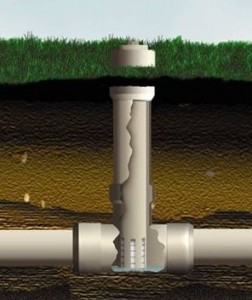 A tablet chlorinator usually consists of a basin where the tubes containing a stack of chlorine tablets are placed. The top of the tubes should extend above the ground surface and be protected by a cap. The bottom tablet in the tube is in contact with the wastewater flowing through the basin. As that tablet dissolves and/or erodes, the tablet above falls by gravity to replace it.
A tablet chlorinator usually consists of a basin where the tubes containing a stack of chlorine tablets are placed. The top of the tubes should extend above the ground surface and be protected by a cap. The bottom tablet in the tube is in contact with the wastewater flowing through the basin. As that tablet dissolves and/or erodes, the tablet above falls by gravity to replace it.
A tablet can dissolve quickly or slowly, depending on the volume and flow of wastewater coming into contact with it, the properties of the tablet, and the length of contact time. A balance must be struck regarding the contact time in the chlorinator basin. If the contact time is too long, the wastewater becomes over-chlorinated and the tablets are consumed rapidly; if the contact time is too short, the wastewater is not disinfected sufficiently.
Use only chlorine tablets that are approved for use in wastewater. They are made of calcium hypochlorite (Ca(OCl)2). These tablets dissolve in the wastewater and release the hypochlorite which then becomes hypochlorous acid, the primary disinfectant.
Do not use swimming pool chlorine tablets. They are often made from trichloroisocyanuric acid, which is not approved for use in wastewater treatment systems. These tablets dissolve too slowly to be effective, and can be explosive if mixed with the wrong ingredients. Read the list of active ingredients on the tablet label to make sure you are using calcium hypochlorite.
Related Resources:
 Tablet Chlorination (and in Spanish)
Tablet Chlorination (and in Spanish)
 Operation and Maintenance Checklist: Disinfection Unit – Chlorine
Operation and Maintenance Checklist: Disinfection Unit – Chlorine